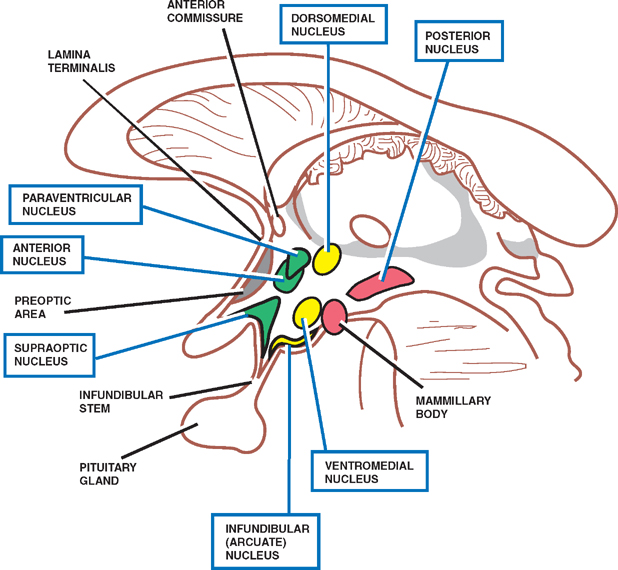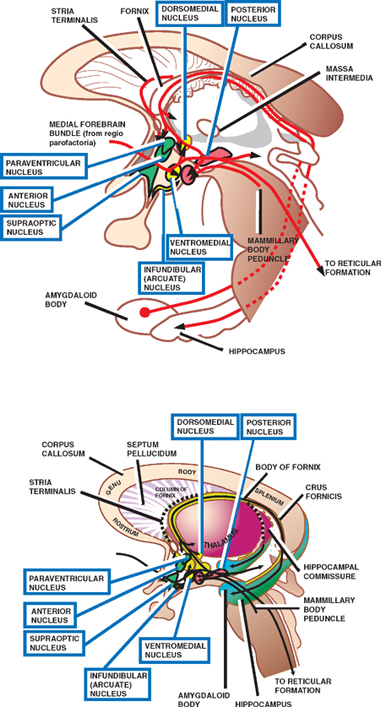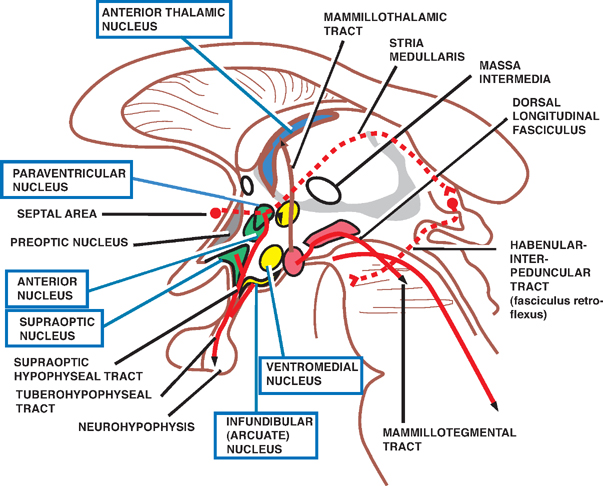10 Hypothalamus The hypothalamus is a small but crucial part of the dien-cephalon that lies below the thalamus and surrounds the lower part of the third ventricle. From ventral to dorsal, the undersurface of the hypothalamus is marked by the optic chiasm, the tuber cinereum, the infundibulum, and the mammillary bodies. The rostral border comprises the anterior commissure and the lamina terminalis; the caudal border merges with the tegmentum of the midbrain. Laterally, the hypothalamus is flanked by the internal capsule; medially, it is flanked by the third ventricle. The hypothalamus exerts its influence through three major systems: (1) the limbic, (2) the autonomic, and (3) the endocrine. It is composed of numerous nuclei of ill-defined boundaries that make connections with many parts of the central nervous system (CNS), including (1) limbic structures, (2) autonomic nuclei of the brainstem and spinal cord, and (3) the pituitary gland. Although specific functions have not yet been assigned to individual hypothalamic nuclei, several afferent and efferent pathways of the hypothalamus have been described, and many functions have been identified. This chapter describes the hypothalamic nuclei; the afferent and efferent connections of the hypothalamus; the limbic, autonomic, and endocrine hypothalamic functions; and the clinical manifestations of selected hy-pothalamic disorders. See Fig. 10.1. The hypothalamus may be divided into a medial hy-pothalamic region that contains the majority of nuclei and a lateral hypothalamic region that contains the major fiber tracts (e.g., the medial forebrain bundle) and a group of diffuse nuclei. The medial hypothalamic area is further subdivided into three regions: (1) the supraoptic region, which lies farthest anterior and includes the supraoptic, suprachias-matic, and paraventricular nuclei; (2) the tuberal region, which lies just posterior to the supraoptic region and includes the ventromedial, dorsomedial, and infundibular nuclei; and (3) the mammillary region, which lies farthest posterior and includes the mammillary body to the posterior nucleus. Fig. 10.1 Hypothalamic nuclei. See Fig. 10.2. The hypothalamus is located in the center of the lim-bic system and receives numerous projections from lim-bic system structures. In addition, the hypothalamus receives ascending afferents from the brainstem reticular formation and descending afferents from the thalamus and cerebral cortex. The major afferent connections of the hypothalamus include the following: Fig. 10.2 Afferent hypothalamic connections. See Figs. 10.3 and 10.4. The hypothalamus is a major output pathway of the limbic system. The efferent connections of the hypothalamus are largely reciprocal to the afferent projections. There are ascending connections to the cortex and thalamus as well as descending connections to the autonomic nuclei of the brainstem and spinal cord. Separately, two hypothalamic pathways project to the pituitary gland. The major efferent connections of the hypothalamus include the following:
Hypothalamus
Hypothalamic Nuclei

Afferent Connections

Efferent Connections

Stay updated, free articles. Join our Telegram channel

Full access? Get Clinical Tree








